Idlewild Park and Soak Zone
Introduction
Text-to-speech Audio
Images
A postcard depicting the Ligonier Valley Rail Road’s train/train tracks leaving the Park. Idlewild’s presence helped turn the Ligonier Valley RR from being a purely coal transport into a vessel for passenger travel. "LHHC"
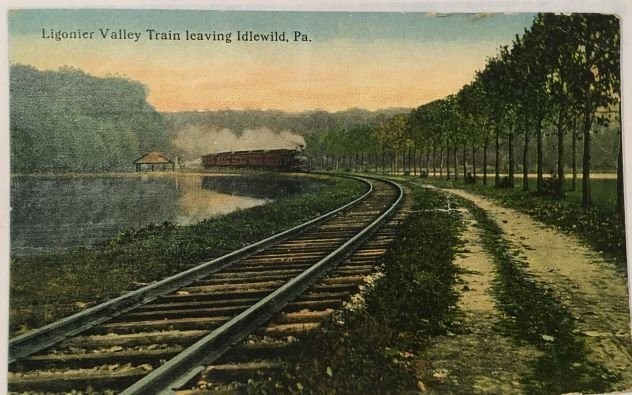
A view of the Ligonier Valley Rail Road Depot. This location of the railroad is what determined the placement of Idlewild in Ligonier, PA. "LHHC"
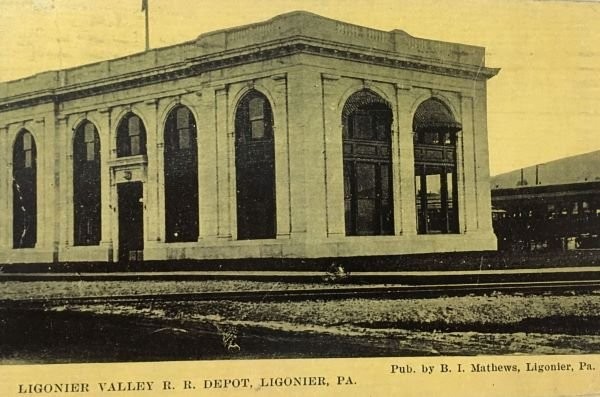
A family posing outside of the Park's man-made lake. The Park's picturesque setting was used to help market the Park as "A Mountain Playground" in the early days. "Croushore"
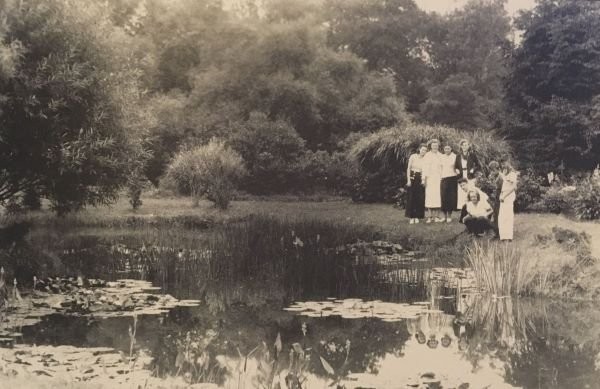
A post card from 1939 depicting the “Flowers and Shrubbery” of the Park. By the late 1930s, the Park had just begun to become an amusement park. The appeal of being in the country was still one the main attractions at this time. "LHHC"
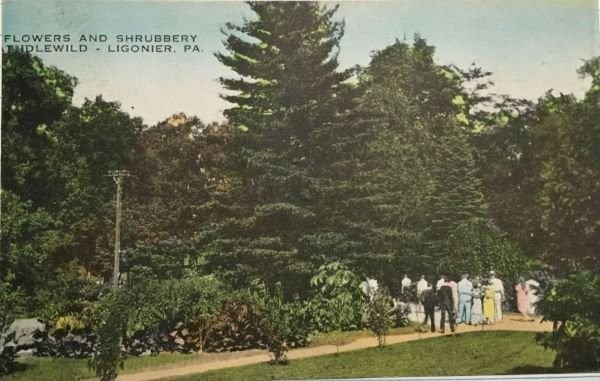
The back of the above post card featuring a message from a Park visitor writing home to his daughter, “Reba.” "LHHC"
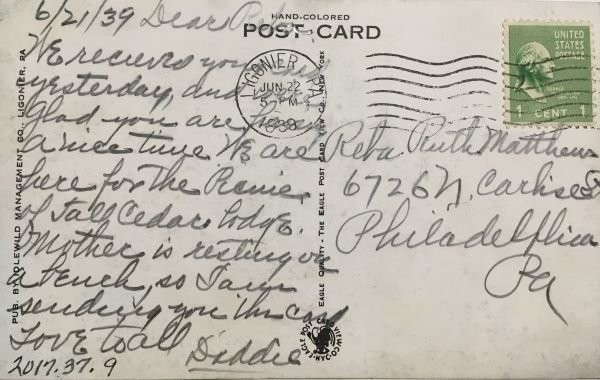
The entrance to "Kidde-Land," C.C. Macdonald's first step in changing Idlewild's audience to families and small children. The tag-line for Idlewild during this time became "You can't beat fun!" "Croushore"
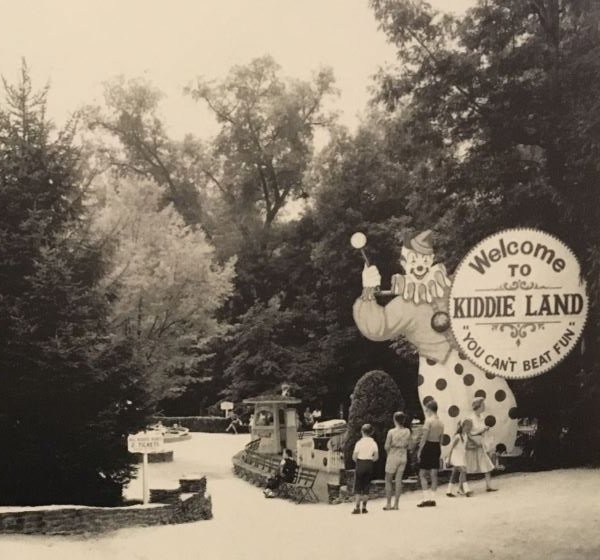
A shot of Arthur Jennings as his clown persona, Happy Dayze. Not only did Jennings create the concept for Story Book Forest, but he also spent many hours on site surveying, designing, and building the actual attraction. "Croushore"
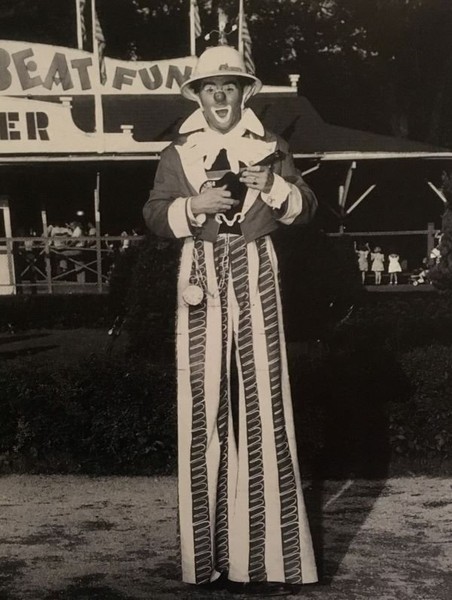
One of the Park's more unique attractions from the 1930s, the Monkey Cage. The monkeys were notorious for getting out, much to the delight of the owner, C.C. Macdonald, who is said to have enjoyed the publicity it brought. "Croushore"
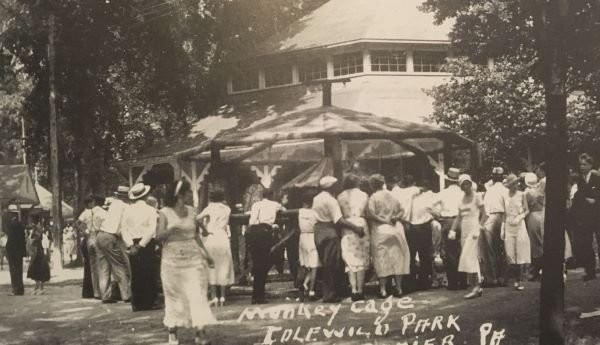
One of the former entrances to Idlewild. This entrance features a service station in response to the popularity of automobile travel and an “Indian Trading Post” where visitors could purchase “Indian Souvenirs and Novelties.” "Butko"
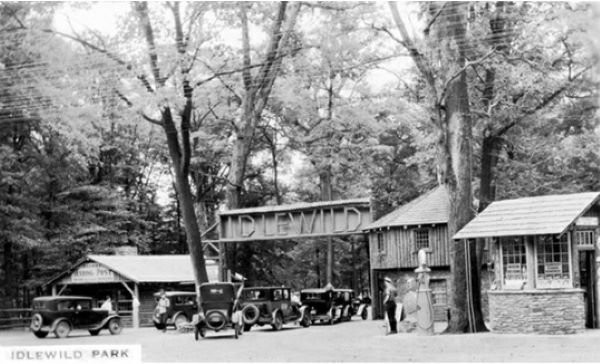
The original entrance to Story Book Forrest in 1956. "LHHC"

The front of a post card featuring children in 50s garb enjoying Story Book Forest. The card’s description says “Children, both young and old, delight when they visit the Golden Knight of Story Book Forest on Route 30 near Ligonier, PA.” "LHHC"
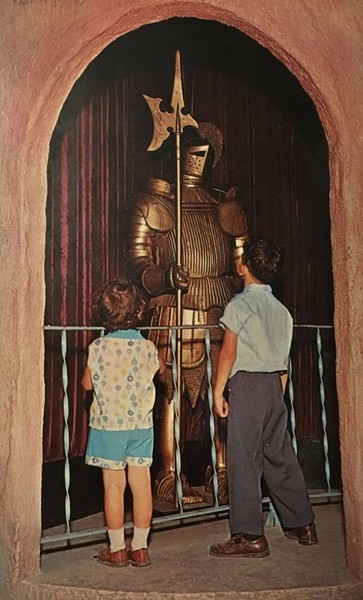
A scene from the now-gone Mister Rogers' Land of Make Believe featuring the end of the ride's "hug-and-sing" party with the characters. Fred Rogers wrote the script and voiced many of the characters' audio for this ride. "Idlewild"
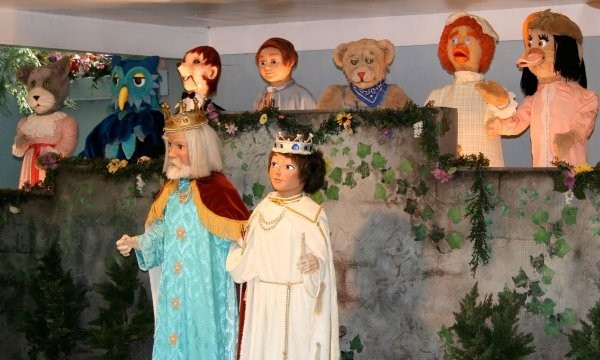
A zoo featuring animals such as raccoons, foxes, and porcupines was added to Idlewild's attractions in 1965. It later became the New Zoo Revue in 1985 and was later replaced by Racoon Lagoon in 1990. "Croushore"
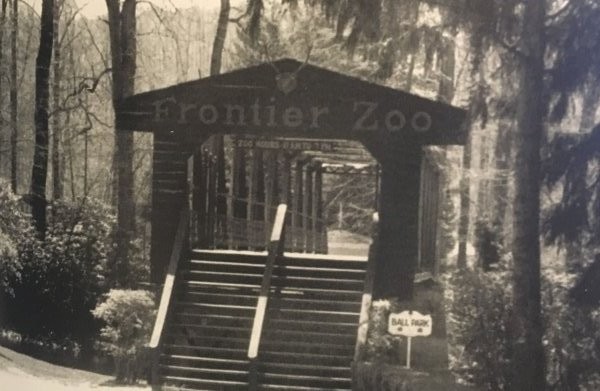
Visitors of all ages enjoy the Rollo-Coaster's 65th anniversary in 2003. "Croushore"
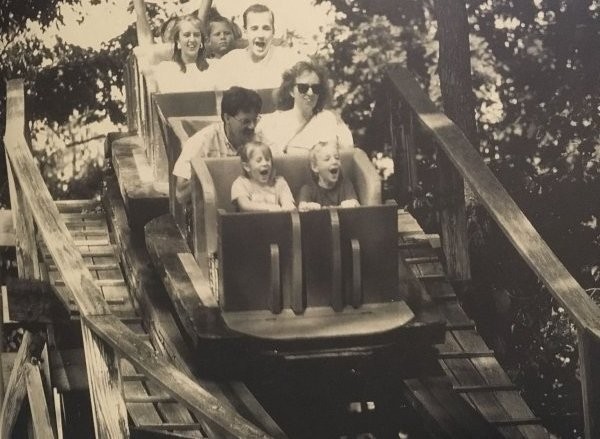
One of the solid wood horses found on the Park’s antique carousel made by the Pittsburgh Toboggan Co in 1930. In 1931, it was brought from the Atlantic City Pier to Idlewild for a permanent stay. "Shawley"
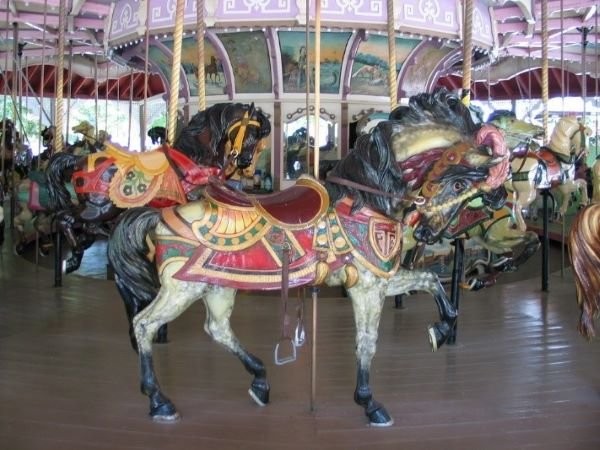
Two park-goers pose with Ricky Raccoon during a visit in 2002. Ricky is the mascot of Raccoon Lagoon, an area of the park dedicated to pint-sized guests. "Croushore"
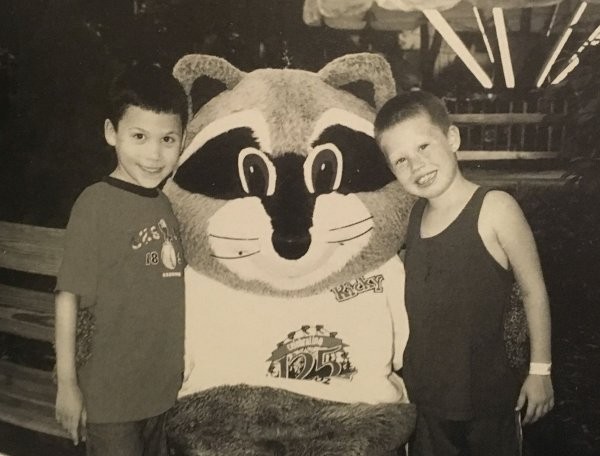
The Pennsylvania historical marker for Idlewild. The park’s status as the longest running amusement park in Pennsylvania and the 3rd oldest in the nation helped to earn this distinction. "Wintermantel"
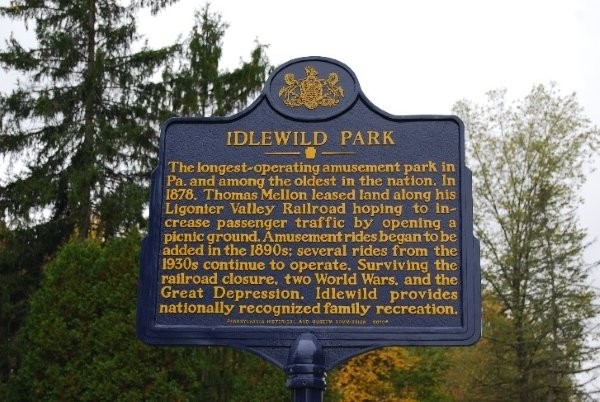
A scene from the 2015 opening of the “Daniel Tiger’s Neighborhood” attraction. It is based off of Fred Rogers Company’s Daniel’s Tiger Neighborhood, the first show to be based off of Rogers’ original neighborhood show. "Idlewild"
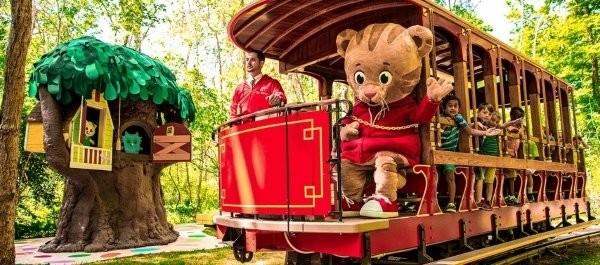
Backstory and Context
Text-to-speech Audio
On May 1st 1887, Judge Thomas Mellon leased land from William Darlington next to Ligonier Valley Railroad for "the right and privilege to occupy his land for picnic purposes or pleasure grounds.” With the hope of attracting travelers to the Railroad, previously a coal transport, Mellon converted the land into a picnic and camp grounds. One year before the park was created, the Civil War ended and cities became congested and industrialized. This congestion prompted crammed city dwellers to seek out “country vacations.” Leisure parks, such as Idlewild, were created in response to this need. The park’s initial grounds included large halls for picnics and spread out areas for camping. The main attraction at these pleasure grounds was the man-made lake where visitors could go fishing and boating.1
Idlewild continued as a country leisure attraction until 1931, when Richard B. Mellon, the son of Judge Thomas Mellon, and amusement park guru C.C. Macdonald decided to expand their operations. Macdonald oversaw the construction of rides, bandstands, pavilions, and lunchrooms to transform Idlewild into a full-fledged amusement park. Some of the rides installed during this time are still present today including the antique Pittsburgh Toboggan Carousel and the “Rollo Coaster."2 Around the same time as the change in Idlewild’s operations came a change in America. Starting in 1929, the Great Depression hit the U.S, changing the way citizens had fun. Despite many amusement parks shutting down due to low attendance, Idlewild was able to sustain itself and create a place of fun during a bleak time in Americans’ lives. Idlewild face another change when America joined World War II. The park was forced to close in 1943 due to low attendance and the national urge for institutions to focus on war efforts. The war did not remove Idlewild ,however because in 1947, they opened up again to receive the surge of families seeking consumer fun in the 1950s.3
In 1952, the Ligonier Valley Railroad closed, but Idlewild adapted by creating a bigger parking lot to accommodate the increase in automobile transport. Under the new management of C.C. Macdonald, Macdonald’s plans of Idlewild becoming a “kiddie” park were underway with the inclusion of miniature rides. In 1954, Arthur Jennings, one of the Park’s performance clowns, approached Macdonald with his dream to create a theme park “based on emotion rather than motion.” A partnership was struck and Jennings’ dream became a reality with the creation of Story Book Forest in 1956. Idlewild and Story Book Forest were at first marketed as two separate sites, but were joined together in 1959, forever cementing Idlewild’s image as a place for kids.4
Fast forward to 1983, the Macdonalds released ownership of the Park and the Kennywood Corporation took over. The decision was two-fold for the Kennywood Corporation. First by taking over Idlewild, the Corporation could ensure that it would not become competition for Kennywood, their primary amusement park in Pittsburgh. Secondly, they could honor the vision of C.C. Macdonald by continuing to develop the park for children or “kiddies” (Futrell). In 1985, the H20hhh Zone was added due to the rise of water-park popularity. Two years later in 1987, Mister Rogers’ Land of Make-Believe was added. In the 1990s, the park updated their water attractions, doubling the water park’s size and earning the name “Idlewild Park and Soak Zone."5
In present times, Idlewild is still operating as a beloved amusement park for local and distant visitors. Today park-goers will find a host of updated attractions including one dedicated to the first television show inspired by Mister Rogers’ Neighborhood, “Daniel Tiger’s Neighborhood.” In addition to rides, there are many seasonal events such as the Memorial Day Salute, HALLOBOO! and the annual Ligonier Highland Games. Due to its success, Idlewild has been named the “Best Park for Families” by National Amusement Park Historical Association and has been the recipient of the Golden Ticket Award for Best Children’s Park eight years in a row.6 With its long history, Idlewild operates today as the third oldest amusement park in the United States and the oldest running park in Pennsylvania. In recognition of its historical significance, Idlewild received a historical marker from the Pennsylvania Historical and Museum Commission in 2012.7
__________________________________________________________________________
1. "The History of Idlewild." Idlewild and Soakzone. Accessed February 13, 2018. https://www.idlewild.com/plan-a-visit/about-idlewild.
2. "The History of Idlewild."
3. Futrell, Jim. Amusement Parks of Pennsylvania. (Mechanicsburg, PA: Stackpole Books, 2002.), 51-63.
4. Croushore, Jeffrey S. Idlewild. Images of America ed. (Chicago, IL: Arcadia Publishing, 2004.), 51.
5. "The History of Idlewild."
6."Family-Friendly Fun & Adventure." Idlewild.com. March 20, 2019. https://www.idlewild.com/things-to-do/attractions. – for attractions
7. Wintermantel, Mike. "Idlewild Park." The Historical Marker Database. October 06, 2016. https://www.hmdb.org/marker.asp?marker=60066.
Sources
Croushore, Jeffrey S. Idlewild. Images of America ed. Chicago, IL: Arcadia Publishing, 2004.
"Family-Friendly Fun & Adventure." Idlewild.com. March 20, 2019. https://www.idlewild.com/things-to-do/attractions. – for attractions
Futrell, Jim. Amusement Parks of
Pennsylvania.
Mechanicsburg, PA: Stackpole Books, 2002.
"The History of Idlewild." Idlewild.com. Accessed March 20, 2019. https://www.idlewild.com/plan-a-visit/about-idlewild.
Wintermantel, Mike. "Idlewild Park." The Historical Marker Database. October 06, 2016. https://www.hmdb.org/marker.asp?marker=60066.
Images:Butko, Brian. The Lincoln Highway: Pennsylvania's Traveler's Guide. 2nd ed. Mechanicsburg, PA: Stackpole Books, 2004.
Croushore, Jeffrey S. Idlewild. Images of America. PA: Arcadia Publishing, 2004:
"Idlewild & SoakZone Opens 138th Season with New Daniel Tiger’s Neighborhood Trolley Ride and Musical Stage ShowIdlewild and Soakzone. Accessed February 13, 2018. https://www.idlewild.com/node/436
Photograph. Latrobe, Pennsylvania. From Lincoln Highway Heritage Corridor Archive (accessed April 3rd, 2019).
Shawley, Ron. "Idlewild Park Carousel." WikiMedia Commons. November 17, 2014. Accessed March 20, 2019. https://commons.wikimedia.org/wiki/File:Idlewild_park_Carousel_-_panoramio.jpg.
Wintermantel, Mike. "Idlewild Park." The Historical Marker Database. October 06, 2016. https://www.hmdb.org/marker.asp?marker=60066.
